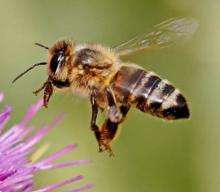July 1, 2010 report
Bees helping to monitor air quality at German airports

(PhysOrg.com) -- Air quality around eight airports in Germany is being monitored with the help of bees, whose honey is tested regularly for toxins.
Using bees for biomonitoring of environmental health around airports is a recent development, but insects have been used successfully for some time to monitor water quality at a number of sites.
The honey produced at the airports is tested in the laboratory twice a year for heavy metals and certain hydrocarbons, and has so far been found to be comparable to honey produced in non-industrial areas. Volker Liebig, a chemist with Orga Lab, which tests the samples, said more data is needed over a longer period for the results to be conclusive, but he said preliminary results looked promising.
Düsseldorf International Airport’s community liaison officer Peter Nengelken said this year’s first batch of honey, harvested in June from the 200,000 bees at the airport, had been tested and found to contain toxin levels far below recommended limits, and about the same as honey from rural areas. This is consistent with the results from the previous years since the bee monitoring began in 2006. Air quality at all the airports is also monitored in more traditional ways.
Pollution at airports has a number of sources, including aircraft, cars, buses, and industries, which often cluster in the vicinity of airports. Around the world the air quality around airports is monitored, and the stringent monitoring requirements set by the International Civil Aviation Organization, a body of the United Nations, have led to a substantial reduction in pollution at major airports.
Pollution reduction has been achieved by the development of cleaner aircraft engines and ground support vehicles, and by improvements in equipment operation procedures. Even so, some community groups remain concerned, especially about lead levels and the presence of ultrafine particles originating from jet aircraft, cars and trucks. In Germany, airport officials view the bees as a simple and easy-to-understand way to demonstrate to the public that airports are much cleaner and safer than they once were.
The health effects of ultrafine particles are unknown as yet but there is some research suggesting they may pose a risk because the particles are fine enough to pass through cell walls and may be able to penetrate into the brain and other organs. Ultrafine particle emissions are currently not regulated in the US, but there are limits for vehicle emissions of ultrafine particles in Europe.
The bees at Düsseldorf International airport are kept by local beekeepers, and the honey is bottled as “Düsseldorf Natural” and given away.
© 2010 PhysOrg.com

















